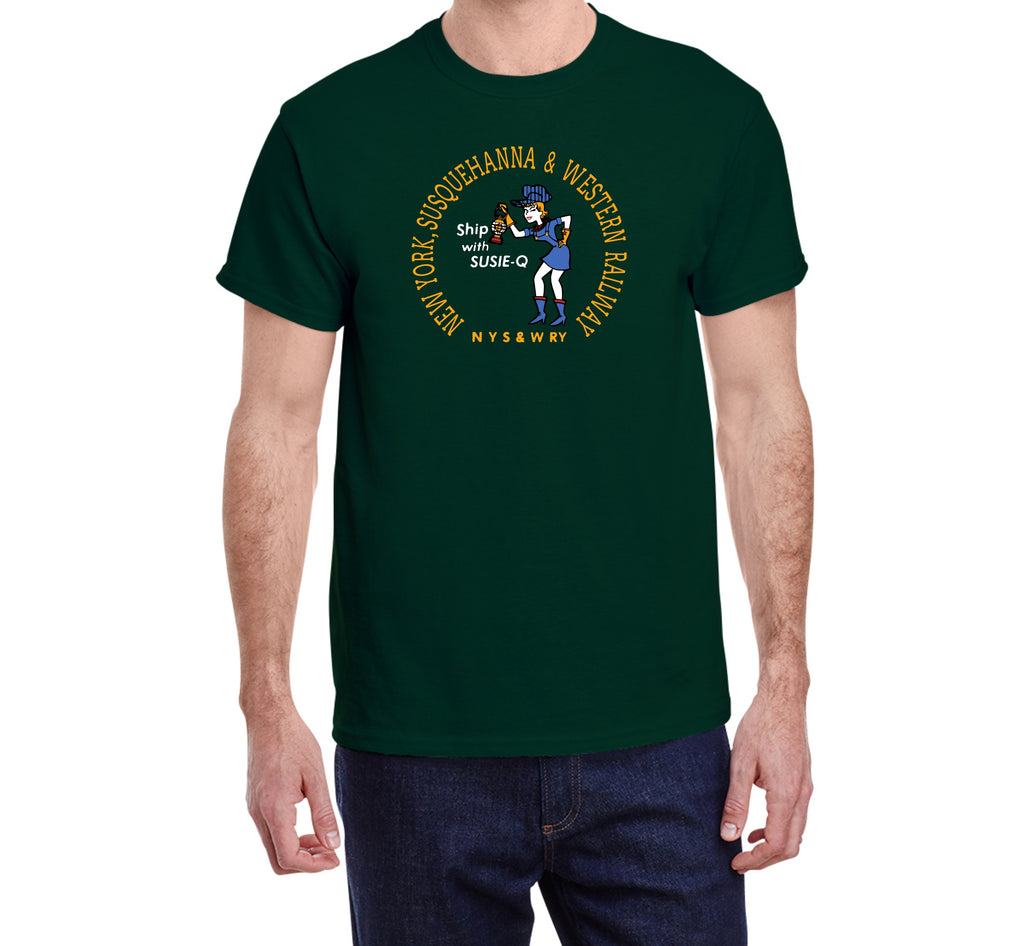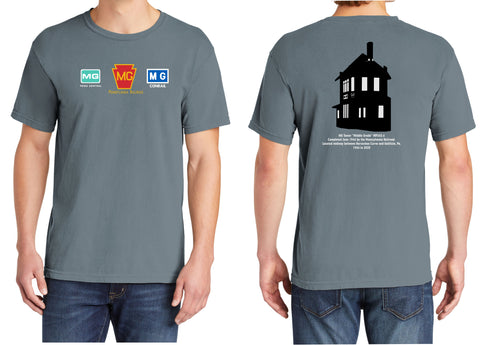
Susquehanna "Susie-Q" Railroad Shirt
Susquehanna "Susie-Q" Railroad Shirt
- Logo Printed on Front
- 100% Cotton
- Shirt Color - Forest Green
The New York, Susquehanna & Western (NYS&W) can trace its roots back to the Hoboken, Ridgefield & Paterson Railroad, chartered in 1866 to connect industrial Paterson, New Jersey, with the ports along the Hudson Waterfront opposite New York City at Hoboken. That same year, the New York and Oswego Midland Railroad (NY&OM) was chartered to connect the Great Lakes port at Oswego, New York, with New York City. Several competing companies sprang up in 1867, but the New Jersey Western Railroad (NJW) was the most successful, constructing westward from Paterson and Hawthorne. Cornelious Wortendyke, president of the NJW, signed a lease agreement with DeWitt Clinton Littlejohn of the NY&OM giving his road a through route into New Jersey. Construction on the NY&OM started in 1868 and progressed rapidly. The NJW changed its name to the New Jersey Midland Railway (NJM) in 1870, and construction had stretched from Hackensack, New Jersey, all the way through to Hanford.[4]
The NY&OM reached Middletown, New York, and leased the connecting Middletown, Unionville and Water Gap Railroad (MU&WG), which reached the NJM at Hanford. The last stretch of construction from Hackensack to Jersey City completed the NJM in 1872. The first through train from Oswego to Jersey City operated on July 9, 1873. While the goals of the two partners had been reached, the Panic of 1873 caused financial ruin for both companies. The NY&OM suspended lease payments, and the agreement was broken. The NY&OM was reorganized as the New York, Ontario and Western Railway in 1879, and went its separate way. The NJM took over the lease of the MU&WG as well. Unable to weather the financial storm, the NJM was put into receivership in 1875.[4]
New York, Susquehanna and Western Railway streamlined locomotive (Motorailer) constructed by the American Car and Foundry company, c.1940
In 1880, the railroad was reorganized as the New Jersey Midland Railroad (NJM), and attention was turned to the lucrative coal fields of eastern Pennsylvania. By 1882, the newly reorganized New York, Susquehanna & Western had extended west to Gravel Place, Pennsylvania, and a connection with the Delaware, Lackawanna and Western Railway (DL&W). The NYS&W also had a connection to the DL&W at Delaware, NJ via the Blairstown Railway. Due to the increased volume of traffic, the railroad was double-tracked from Paterson to Jersey City in 1887. To reach the port on the Hudson River waterfront, traffic was handed off to the Pennsylvania Railroad at Marion Junction via the Hudson Connecting Railway. To keep more of the line haul revenue for themselves, the Susquehanna extended their line from their Little Ferry Yard through the new Palisades Tunnel to a new terminal at Edgewater where they had constructed coal docks for transfer from train to boat in 1892. The NYSW also reached west of the Delaware River and leased the Wilkes-Barre and Eastern Railroad to access the Scranton area directly and divert traffic away from the Lackawanna.[5]
American financier J.P. Morgan began to take notice of this rapidly expanding coal-hauler, and quietly bought up its stock on behalf of the Erie Railroad. The railroad was leased by the Erie in 1898, and soon after took over complete operation of the line.[6][7][8]
The NYS&W fell on hard times during the economic recession of 1957. The NYS&W lost its western connection to the Lehigh and New England Railroad when the L&NE ceased operations in 1961, resulting in the NYS&W pulling up all its track west of Sparta Jct. (which now comprises what is now known as the Paulinskill Valley Trail). Thereafter, the NYS&W sold off its nearly new Budd passenger cars and replaced them with second-hand used equipment. Desperate to close its money-losing commuter service, the railroad's trustees offered its commuters $1,000 each to stop using the trains. Permission to end commuter service was granted in 1966. Washouts caused by Tropical Storm Doria (1971) cut off other connections, and the railroad retreated to Butler, New Jersey.




